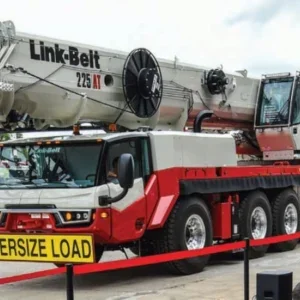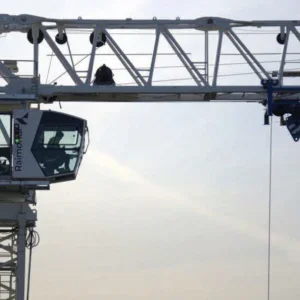Manitowoc Crane Group acquired Shirke Construction Equipment, its Potain manufacturing licensee and dealer in India, in July, from its founder, BG Shirke, who will continue his construction contractor business BG Shirke Construction Technology with son Vijay. The new MCG business will be known as Potain India.
TR Badarinarayan, formerly CEO of Shirke, has been named president of Potain India. His new boss will be the as-yet unnamed executive vice president of Asia-Pacific, the replacement to Eric Etchart. In the meantime he is reporting to Etchart and a Manitowoc management team.
The new business’s headquarters and factory are in Pune, with offices in Delhi, Mumbai, Bangalore and Hyderabad. Manitowoc says that the factory has a similar output to any European Potain manufacturing units, including Moulin in France, or to Zhangjiangang in China.
Will Dalrymple: What was the history of Shirke?
TR Badarinarayan: First and foremost, we were a family-owned company. We started manufacturing in 1972 with Richier. We manufactured cranes under a licence. We would buy the mechanisms from Richier, and do the complete crane structure in India.
In 1982, following the takeover of Richier by Potain, we had a deal with Potain. We started manufacturing models like the E1/13B, E2/18B, G3/33B, with technical back-up from Potain.
Choosing the models to make was always strategic. We had feedback from the market, and expertise from France: they supported us, and we were deciding together on which models to make.
The cranes we made were the fast-moving popular models, where we benefited from short deliveries. The cranes we imported direct from the European factory were rare, speciality, one-offs.
Two very popular cranes recently have been the MC 85 and MC 115. These models are identical to the Potain cranes, following the same design drawings. These are exactly interchangeable, as Potain would have built them.
The contribution of Potain is the mechanism. We import the drive units, hoist winch, slew, trolley winch. We were doing the entire crane structure to Potain designs and drawings.
There are about 350 employees including workers, working one or two shifts depending on the load. It is very flexible. We are manufacturing to cater to the market, and market demand, so there are no hard and fast rules. The sales in Sri Lanka, Bangladesh, Bhutan and Nepal are areas we need to grow.
The company is going to change. I am shouldering a very great responsibility to integrate a family-owned company into a global organisation that is matrix-based. I have trained people to be ready for this day.
As a mechanical engineer, I continue to have responsibility for the factory and for sales. I am looking to build a team to look over this. Sales is my strong point anyway.
I started my career at Shirke in 1988 as general zonal manager of production and marketing. As the company grew, I changed position, becoming general manager, vice-president, and I grew to be the CEO, which I have been for nearly nine years.
We are only a three-day-old baby. In the last three days, I have gotten to know the operations in Wisconsin, and in other areas, and the needs that we may have as an Indian company to bring it up to that level. We have some administration engineering to do on that part, to see if there are any shortfalls in an operation run as a family company. These are on one side, and the other is the routine job: production, invoicing and selling.
It is a great opportunity for us to learn, be part of a global player, a leader in lifting solutions.
WD: What input do you expect from Potain?
TRB: New models. The market is getting diversified, and the type of crane will change. Plus we want to upgrade the existing ones to make them more productive. We are not interested in refreshing the range, it is about add-ons, reassessments, rearrangements. There are currently seven models in the range.
We need to talk about productivity. We need to be more efficient and upgrade our facilities. Being a manufacturing base, we are set up well. If Potain would like to take something from us, if it is developing cranes for the third world, they can take the production out of India, if and when factory improvements are complete, and cater to the Indian market, and if there is surplus, they can contribute to the global market.
WD: Would you please describe the Indian tower crane market?
TRB: In the last few years, India has definitely been growing. When you talk about growth, and construction, this is possible by using construction equipment such as cranes. In the last three years, we have been getting bigger and bigger. The demand for cranes has picked up, following a period of low investment in infrastructure.
In India crane rental is not that popular, although it is going here and there. Generally the end users buy and own cranes.
Customers are globally exposed. Most foreign construction companies are working with Indian construction companies. They are fairly well educated, know their needs and the advantages of the equipment.
The MC 85 and MC 115 are used for housing projects and infrastructure, both of which are growing in India. You find many cranes working in India.
It is hard to say the position of Potain prices in the market. Cranes are generally custom-built: customers choose different versions, jib length and height. Quality has been what has guided Potain tower crane marketing, not price.
Customers expect technical backup: how to use the crane correctly and economically, and aftersales service. If you don’t have service, the crane stops work on the site for a few days, and that is expensive.
We do offer training. That is one of our strong points. We need to give in-house and site training: that is normally done. We customise it to help the customer choose the right crane, with the right use, in the right place.
Just selling the crane is not the business. The business is to ensure that the customers can use the crane to its fullest ability.
The operator generally has to be certified by us. If he is up in the cabin 50m, 60m, 70m, we explain to him the signs, how to use the walkie-talkie, how to use the controls, and troubleshooting. We don’t want him to panic if the crane stops for a silly reason. The first steps are to check what has gone wrong, and it might not be necessary to call a service technician.
Normally the government requires that the manufacturer certifies that the right man is using this equipment.
Potain India’s factory Potain India’s factory TR Badarinarayan, president of Potain India TR Badarinarayan






